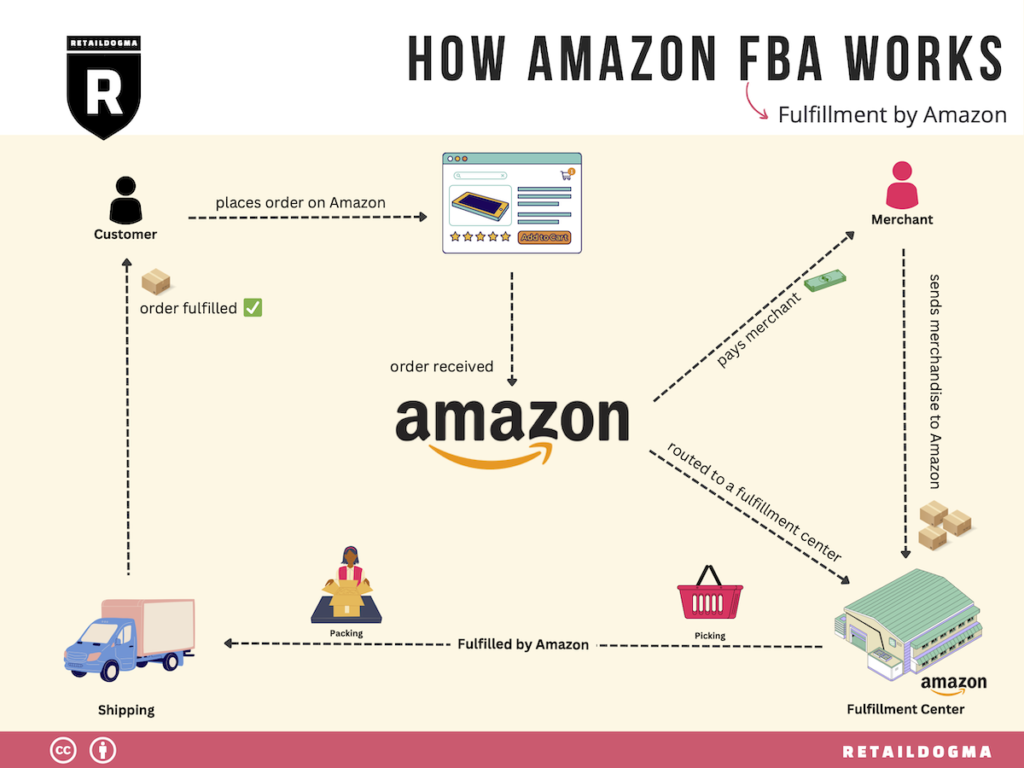If you’re considering selling products online, you’ve likely come across the term Amazon FBA. Short for Fulfillment by Amazon, FBA is a powerful service that allows sellers to leverage Amazon’s vast logistics network to store, pack, and ship their products. This guide will delve into what Amazon FBA is, how it works, its benefits and drawbacks, and tips for getting started.
What is Amazon FBA?
Amazon FBA (Fulfillment by Amazon) is a service provided by Amazon that handles the storage, packaging, shipping, and customer service for third-party sellers. Instead of managing these aspects yourself, you send your inventory to Amazon’s fulfillment centers, and Amazon takes care of the rest. This allows sellers to focus on sourcing products, marketing, and growing their businesses without worrying about the logistical challenges of order fulfillment.

How Does Amazon FBA Work?
Here’s a step-by-step overview of how Amazon FBA operates:
- Create an Amazon Seller Account: To use FBA, you first need to sign up for an Amazon Seller Central account. You can choose between an Individual or Professional plan based on your business needs.
- List Your Products: Add the products you want to sell to your Amazon inventory. You can list new products or add to existing listings.
- Prepare Your Inventory: Ensure your products are properly packaged and labeled according to Amazon’s guidelines. This may involve specific packaging requirements, barcoding, and labeling instructions.
- Ship to Amazon Fulfillment Centers: Send your inventory to Amazon’s designated fulfillment centers. Amazon provides detailed shipping plans and guidelines to streamline this process.
- Storage and Inventory Management: Once received, Amazon stores your products in their fulfillment centers. You can monitor your inventory levels and sales through your Seller Central dashboard.
- Order Processing and Shipping: When a customer places an order, Amazon picks, packs, and ships the product directly to the customer. They also handle returns and customer inquiries related to fulfillment.
- Customer Service and Returns: Amazon manages customer service for FBA orders, including handling returns and refunds, ensuring a seamless experience for buyers.

Benefits and Drawbacks of Using Amazon FBA
| Benefits | Drawbacks |
|---|---|
| Prime Eligibility: Products fulfilled by Amazon are eligible for Amazon Prime, giving them access to millions of Prime members who prefer fast, free shipping. Scalability: FBA allows you to scale your business without worrying about expanding your own warehouse or hiring additional staff. Multi-Channel Fulfillment: Beyond Amazon, you can use FBA to fulfill orders from other sales channels, such as your own website or other marketplaces. Customer Trust and Reliability: Amazon’s reputation for reliable and fast shipping can enhance customer trust in your products. Time Savings: Outsourcing fulfillment tasks frees up your time to focus on other aspects of your business, such as marketing, product development, and customer engagement. Global Reach: With Amazon’s extensive logistics network, you can reach international customers more easily, expanding your market beyond local or national boundaries. | Costs: FBA fees include storage fees, fulfillment fees, and additional costs for services like labeling and removal. These can add up, especially for low-margin products. Inventory Management: Keeping track of inventory levels is crucial to avoid stockouts or excessive storage fees. Poor inventory management can impact profitability. Loss of Control: Relying on Amazon for fulfillment means you have less control over the packaging, shipping speed, and handling of your products, which can affect brand perception. Competition: Selling on Amazon means competing with numerous other sellers, including Amazon itself, which can lead to price wars and reduced margins. Long-Term Storage Fees: If your products remain unsold for extended periods, Amazon may charge long-term storage fees, impacting your profitability. |
Costs Associated with Amazon FBA
Understanding the costs involved is essential for determining whether FBA is right for your business. Key costs include:
- Fulfillment Fees: Charged per unit, these fees cover picking, packing, and shipping your products. They vary based on the product’s size and weight.
- Storage Fees: Monthly fees based on the volume (measured in cubic feet) your inventory occupies in Amazon’s fulfillment centers. Rates can increase during peak seasons like holidays.
- Additional Fees: Costs for services such as labeling, removal of inventory, and long-term storage fees for items stored for over 365 days.
- Referral Fees: A percentage of each sale, which varies by product category.
Tips for Success with Amazon FBA
- Optimize Product Listings: High-quality images, compelling descriptions, and relevant keywords can improve your product’s visibility and conversion rates.
- Manage Inventory Wisely: Use inventory management tools to track stock levels and forecast demand to prevent stockouts and minimize storage fees.
- Choose Profitable Products: Conduct thorough market research to select products with healthy margins after accounting for FBA fees and other expenses.
- Leverage Amazon Advertising: Invest in Amazon’s advertising options like Sponsored Products and Sponsored Brands to increase visibility and drive sales.
- Monitor Performance Metrics: Keep an eye on key performance indicators (KPIs) such as sales volume, return rates, and customer feedback to continuously improve your offerings.
- Maintain High Seller Ratings: Providing excellent customer service and ensuring product quality helps maintain high seller ratings, which can influence buyer trust and sales.
- Stay Informed About Amazon Policies: Amazon frequently updates its policies and fee structures. Staying informed helps you comply and adapt to changes effectively.
Is Amazon FBA Right for You?
Amazon FBA can be a game-changer for many online sellers, offering numerous advantages like scalability, Prime eligibility, and reduced logistical burdens. However, it’s essential to weigh these benefits against the associated costs and potential drawbacks. Conduct a thorough analysis of your business model, product margins, and long-term goals to determine if FBA aligns with your strategy.
Conclusion
Amazon FBA provides a robust solution for sellers looking to streamline their operations and tap into Amazon’s extensive customer base. By handling the complexities of storage, packaging, and shipping, FBA allows you to focus on growing your business and enhancing your product offerings. However, success with FBA requires careful planning, effective inventory management, and a keen understanding of the costs involved. With the right approach, Amazon FBA can be a powerful tool in building a thriving online business.







